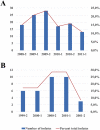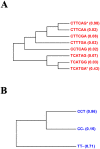Leishmania braziliensis causing human disease in Northeast Brazil presents loci with genotypes in long-term equilibrium
- PMID: 35704664
- PMCID: PMC9239440
- DOI: 10.1371/journal.pntd.0010390
Leishmania braziliensis causing human disease in Northeast Brazil presents loci with genotypes in long-term equilibrium
Abstract
Background: Leishmaniases are neglected tropical diseases that inflict great burden to poor areas of the globe. Intense research has aimed to identify parasite genetic signatures predictive of infection outcomes. Consistency of diagnostic tools based on these markers would greatly benefit from accurate understanding of Leishmania spp. population genetics. We explored two chromosomal loci to characterize a population of L. braziliensis causing human disease in Northeast Brazil.
Methodology/principal findings: Two temporally distinct samples of L. braziliensis were obtained from patients attending the leishmaniasis clinic at the village of Corte de Pedra: (2008-2011) primary sample, N = 120; (1999-2001) validation sample, N = 35. Parasites were genotyped by Sanger's sequencing of two 600 base pairs loci starting at nucleotide positions 3,074 and 425,451 of chromosomes 24 and 28, respectively. Genotypes based on haplotypes of biallelic positions in each locus were tested for several population genetic parameters as well as for geographic clustering within the region. Ample geographic overlap of genotypes at the two loci was observed as indicated by non-significant Cusick and Edward's comparisons. No linkage disequilibrium was detected among combinations of haplotypes for both parasite samples. Homozygous and heterozygous genotypes displayed Hardy-Weinberg equilibrium (HWE) at both loci in the two samples when straight observed and expected counts were compared by Chi-square (p>0.5). However, Bayesian statistics using one million Monte-Carlo randomizations disclosed a less robust HWE for chromosome 24 genotypes, particularly in the primary sample (p = 0.04). Fixation indices (Fst) were consistently lower than 0.05 among individuals of the two samples at both tested loci, and no intra-populational structuralization could be detected using STRUCTURE software.
Conclusions/significance: These findings suggest that L. braziliensis can maintain stable populations in foci of human leishmaniasis and are capable of robust genetic recombination possibly due to events of sexual reproduction during the parasite's lifecycle.
Conflict of interest statement
The authors have declared that no competing interests exist.
Figures





Similar articles
-
Molecular epidemiology and in vitro evidence suggest that Leishmania braziliensis strain helps determine antimony response among American tegumenary leishmaniasis patients.Acta Trop. 2018 Feb;178:34-39. doi: 10.1016/j.actatropica.2017.10.010. Epub 2017 Oct 16. Acta Trop. 2018. PMID: 29042262 Free PMC article.
-
Dynamics of American tegumentary leishmaniasis in a highly endemic region for Leishmania (Viannia) braziliensis infection in northeast Brazil.PLoS Negl Trop Dis. 2017 Nov 2;11(11):e0006015. doi: 10.1371/journal.pntd.0006015. eCollection 2017 Nov. PLoS Negl Trop Dis. 2017. PMID: 29095818 Free PMC article.
-
Atypical Manifestations of Cutaneous Leishmaniasis in a Region Endemic for Leishmania braziliensis: Clinical, Immunological and Parasitological Aspects.PLoS Negl Trop Dis. 2016 Dec 1;10(12):e0005100. doi: 10.1371/journal.pntd.0005100. eCollection 2016 Dec. PLoS Negl Trop Dis. 2016. PMID: 27906988 Free PMC article.
-
Multiclonal Leishmania braziliensis population structure and its clinical implication in a region of endemicity for American tegumentary leishmaniasis.Infect Immun. 2004 Jan;72(1):508-14. doi: 10.1128/IAI.72.1.508-514.2004. Infect Immun. 2004. PMID: 14688132 Free PMC article.
-
Geographic clustering of leishmaniasis in northeastern Brazil.Emerg Infect Dis. 2009 Jun;15(6):871-6. doi: 10.3201/eid1506.080406. Emerg Infect Dis. 2009. PMID: 19523284 Free PMC article.
Cited by
-
Diversity and natural infection of phlebotomine sand flies (Diptera, Psychodidae) in an endemic area of American tegumentary leishmaniasis in southeastern Bahia, Brazil.Parasit Vectors. 2025 Feb 26;18(1):79. doi: 10.1186/s13071-025-06717-y. Parasit Vectors. 2025. PMID: 40011928 Free PMC article.
References
-
- Hotez PJ, Bottazzi ME, Franco-Paredes C, Ault SK, Periago MR. The neglected tropical diseases of Latin America and the Caribbean: a review of disease burden and distribution and a roadmap for control and elimination. PLoS Negl Trop Dis. 2008/09/30. 2008;2: e300. doi: 10.1371/journal.pntd.0000300 - DOI - PMC - PubMed
-
- Guimaraes LH, Machado PR, Lago EL, Morgan DJ, Schriefer A, Bacellar O, et al.. Atypical manifestations of tegumentary leishmaniasis in a transmission area of Leishmania braziliensis in the state of Bahia, Brazil. Trans R Soc Trop Med Hyg. 2009/06/02. 2009;103: 712–715. doi: 10.1016/j.trstmh.2009.04.019 - DOI - PMC - PubMed
Publication types
MeSH terms
Grants and funding
LinkOut - more resources
Full Text Sources
Medical
Miscellaneous

